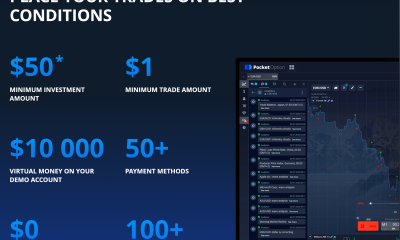Cryptocurrency
7 Best Solana (SOL) Wallets: Full Comparison (Updated 2024)
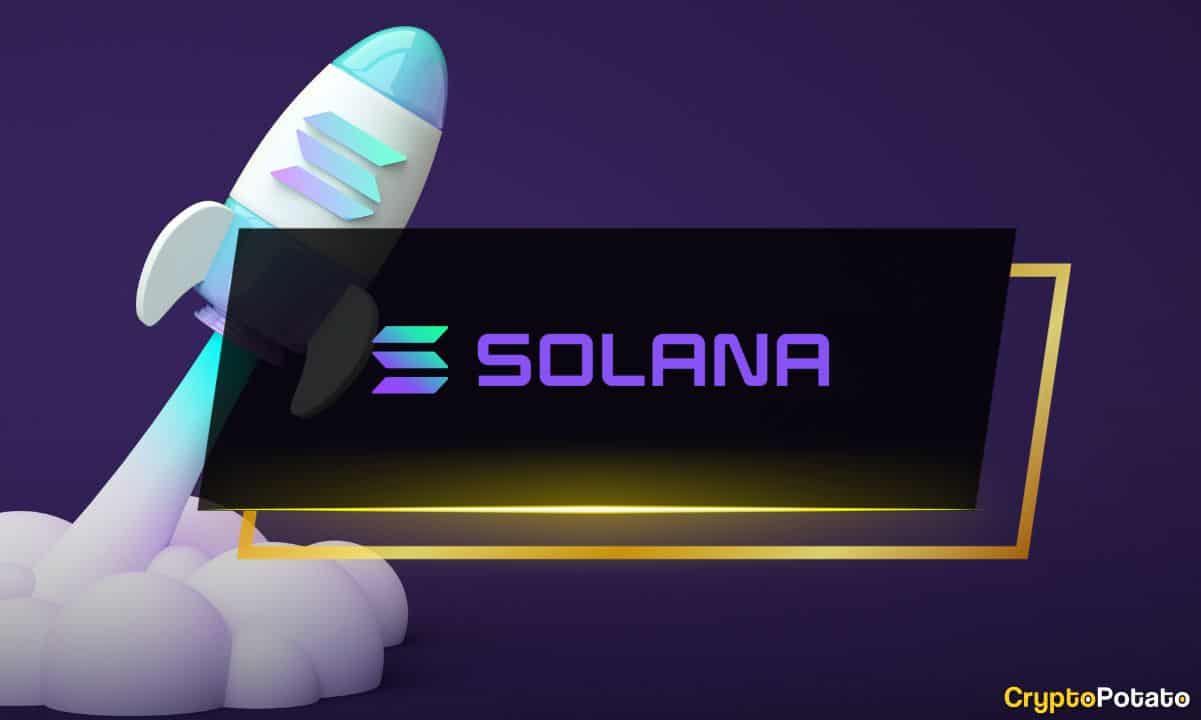
Solana is one of the largest blockchain ecosystems, boasting thousands of decentralized applications. With a vast sea of web3 projects and apps on Solana waiting to be explored, it’s crucial that we pick the right wallet that suits our needs.
Whether you’re a seasoned user or a newcomer to Solana’s blockchain ecosystem, finding the best Solana wallet (tailored to your needs) is crucial. This guide explores some of the most popular options, as well as their pros, cons, distinctive benefits, and what you should be aware of before creating your new address.
Before we dive deeper, however, if you want to find out more about the network and its ecosystem, take a look at our comprehensive Solana blockchain guide.
Without any further ado, let’s take a look at the best Web3 wallets for Solana.
Comparison of the Best Web3 Wallets for Solana
Phantom – The Most Popular Choice
Phantom is the most popular Solana wallet in terms of user base (as of writing these lines) — thanks to its multi-purpose design, user-friendly interface, high performance, and low gas fees.
This non-custodial wallet is popular among SOL stakers due to its simplified staking process and user-friendly interface. This makes it a preferred choice for over half a million monthly users. It’s available as a web browser extension for Brave, Firefox, and Chrome — and it’s also available on mobile.
The mobile version is intuitive, allowing users to tab between their funds, non-fungible tokens (NFTs), swap functions, settings, and more. Phantom is a solid choice due to its beginner-friendly and straightforward interface.
However, that doesn’t mean the wallet is simplistic:
- Storing: SOL, Solana NFTs, and SLP tokens (which mean Solana Program Library, a token standard for building fungible and on-fungible tokens using Solana smart contracts, similar to Ethereum’s ERC-20.)
- Swapping: Phantom provides instant swaps with 0.85% transaction fees (keep in mind this is a flat fee) thanks to an integration with the Automated Market Maker (AMM) Raydium.
- Staking SOL by selecting a validator to stake your tokens with. You can check out StakeView to determine which Solana validators offer the best APY estimates.
- Cross-chain swapper: designed to bring liquidity from the Ethereum ecosystem, this feature supports all EVM tokens and bridges them to USDC, USDT, or DAI.
- Cold wallet integration with Ledger.
The cons? As with everything, there are some drawbacks to Phantom as well.
- Users have to spend a considerable time studying which validators to stake their tokens with. The most popular ones, while offering the highest APY, are often the most expensive.
Phantom key features summary:
- Staking: yes
- Swap: yes
- Interface: mobile, browser extension
- HD wallet integration: yes — Ledger
- Other chains supported: Ethereum and Polygon
Solflare – For The Most Experienced Users
Designed by Solana Labs, Solflare was one of the first wallets in the ecosystem alongside Phantom, with identical functionalities, such as token swapping, NFT storage, Ledger integration, and SOL staking. It’s accessible on Google Play, the App Store, and as a Chrome extension.
Despite being nearly identical to Phantom both on its web application and mobile version, Solflare presents some unique capabilities:
- Direct fund management thanks to an integration with the Solrise platform
- MetaMask integration for Solana dApps
- A 24-word mnemonic phrase for enhanced security.
- Besides supporting staking, swapping, and bridging operations, Solflare is compatible with Solana Pay, a payment network offering low-cost, fast transactions.
Solflare key features summary:
- Staking: yes
- Swap: yes
- Interface: mobile, browser extension
- HD wallet integration: yes — Ledger
- Other chains supported: no, but you can use the Solana Snap feature to connect Solflare to MetaMask and bridge assets from different blockchains
Atomic Wallet – Higher Yields, Higher Cost
Atomic Wallet stands out due to its high staking yields and a wide range of crypto assets — over 1000 coins available for buying, selling, staking, swapping, and earning rewards.
Staking rewards vary, with top performers like Cosmos, AWC, and Zilliqa throwing the highest yields. However, larger-cap coins like Cardano, Solana, and Ethereum remain the most popular staking options, with lower yields.
Those who wish to stake can find out more about it in this guide.
All crypto purchases on Atomic are made through its parent Simplex, a centralized on-ramp fiat platform (which also means the user must complete a KYC). That said, here’s a breakdown of Atomic Wallet fees:
- Buying Cryptocurrencies: flat 5% fee (minimum $10) through Simplex
- Crypto transactions: no fees for incoming or outgoing transactions (except the network fee for blockchain transactions, paid to miners as for any other crypto transaction)
- Extra fees: none, but it does charge additional fees on swaps —0.5%. However, all swaps are facilitated through ChangeNow, meaning the user must also cover ChangeNow’s fees.
Moreover, Atomic Wallet allows users to store their NFTs from Ethereum, Solana, BNB Chain, Polygon, Avalanche, and Fantom.
As you may have noticed, Atomic’s main drawback is the fees — a 2% fee (minimum $10) on top of Simplex’s 5% fee. The second drawback is the lack of robust security features. The wallet only relies on a PIN or password for protection and a 12-word passphrase, and there is no support for multi-sig permissions, no integrations with cold wallets, and no Two-Factor Authentication (2FA).
Atomic Wallet key features summary:
- Staking: yes
- Swap: yes
- Interface: mobile, browser extension
- HD wallet integration: no
- Other chains supported: Over 30 blockchains, including popular networks such as Ethereum, Fantom, Arbitrum, Polygon, Binance Smart Chain, Avalanche, Aurora, and more.
Exodus
Exodus is a non-custodial and multi-functional wallet that works for Solana as well as many other networks.
The Solana Wallet Adapter is integrated with the Exodus Mobile app, allowing users to connect their Solana decentralized applications (dApps) to their wallets or access a vast sea of dApps from several blockchain ecosystems.
It is accessible on desktop, mobile, and browser applications, supporting functionalities like token staking and swapping. Exodus announced its support for Solana in late 2020, and all their desktop, mobile, and hardware crypto wallets inherently support the SOL token.
When utilizing Solana on Exodus, users can expect the following fees:
- Staking Fees: No fees for staking Solana, but a 0.00005 SOL fee for unstaking, deducted from the minimum balance.
- Solana Pay Fees: Transactions on Solana Pay have a low fee of 0.00005 SOL, equivalent to less than a penny.
- Exchange Fees: A small fee applies to cryptocurrency exchanges within the wallet, with the exact percentage unspecified.
Pro tip: unlike the other wallets, Exodus has its own staking validator called Everstake. This means staking assets is a more direct process instead of choosing between dozens of validators.
The cons: like other wallets, it uses a 12-word seed phrase and has no 2FA. In other words, more security measures equal more safety in the long run.
Exodus key features summary:
- Staking: yes
- Swap: yes
- Interface: mobile, desktop, browser extension
- HD wallet integration: yes — Trezor
- Other chains supported: Bitcoin, Ethereum, Binance Smart Chain, Polygon, Solana, and Cardano
Trust Wallet
Trust Wallet is one of the top-rated wallets in the market.
You won’t get bored with Trust Wallet as you can store and stake SOL to earn rewards through the Trust Wallet interface, as well as having full control of your assets.
Here’s what you can do with Trust Wallet:
- Staking SOL: Similar to other wallets, you’ll have to choose the amount and the validator you wish to stake your SOL with.
- Browse Solana dApps: Trust Wallet also supports several Solana dApps. This ranges from automated market makers, lenders, and yield farming apps such as Solend, Bonfida, Raydium, Jupiter, Marinade Finance, and more.
- Buy unique Solana-based NFTs and swap SLP tokens on the Solana network.
All said and done, Trust Wallet is a solid choice if you wish to store and stake your SOL while exploring the Solana ecosystem all in one wallet.
Trust Wallet key features summary:
- Staking: yes (earn yield using Trust Wallet on dApps)
- Swap: yes
- Interface: mobile, desktop, browser extension
- HD wallet integration: yes — Ledger
- Other chains supported: over 70+ blockchains supported, including Ethereum, Solana, Binance Smart Chain, and more.
MetaMask (Solflare Snap)
MetaMask is arguably the most popular self-custodial Web3 wallet in the industry, trusted by over 20 million users, but that doesn’t mean it supports every blockchain out there. When it comes to Solana, it’s important to note that MetaMask is incompatible right off the bat.
However, users can take advantage of Solana Snap for MetaMask. This is an isolated program that allows MetaMask users to manage their SOL tokens and NFTs while also gaining access to the Solana ecosystem of dApps.
In short, the program provides Solana-specific functionalities on the MetaMask wallet without needing multiple third-party wallets.
To install the Solana Snap for MetaMask, visit the Solflare MetaMask landing page and follow the steps.
MetaMask key features summary:
- Staking: yes (earn yield using Trust Wallet on dApps)
- Swap: yes
- Interface: mobile, browser extension
- HD wallet integration: yes — Ledger, Trezor AirGap Vault, Keystone (the only one available on Extension and Mobile), and Lattice
- Other chains supported: supports all EVM-compatible blockchains and layer-2 solutions, including Arbitrum, Polygon, Binance Smart Chain, Fantom, Harmony, Avalanche, and Aurora.
Mathwallet
Mathwallet might not be as popular as the other options, but its vast features provide a sharp edge. It’s available for several platforms, including desktop, mobile, and browser, and even has a Ledger integration.
This wallet is more of a web3, multi-purpose application supporting over 100 blockchains. It allows users to perform DeFi activities, including navigating dApps on a wide range of networks and staking SOL and other cryptos.
Mathwallet acts as more than just a wallet — it’s a web3 browser that incorporates developer tools for builders, a dApp store, a “MathVerse” which contains NFT lands and avatars, a MATH token to redeem for MATH products, and a MathStaking, which allows you to choose between several validators to stake your funds.
It also incorporates a gas tracker called MATHGas, which is a handy feature.
The above were all the highlights, but there are also some considerations:
- Customer support is somewhat negligent
- It can be slow to load certain features
MathVault key features summary:
- Staking: yes
- Swap: yes
- Interface: mobile, browser extension
- HD wallet integration: yes — Ledger
- Other chains supported: supports over 100 blockchains, including popular networks such as Ethereum, Fantom, Arbitrum, Polygon, Binance Smart Chain, Avalanche, Aurora, and more.
Hardware Wallets Supporting Solana
While you can use hot wallets for increased security and for higher amounts, it’s recommended to integrate a hardware wallet (cold storage) when storing your valuable SOL tokens. In crypto, the old saying “better safe than sorry” is worth remembering.
The benefit of cold storage is the mitigation of hacks and other types of cyberattack since the device is not connected to the internet. But yet, there are limitations to cold wallets. For example, if you’d signed a malicious transaction even when using an HD wallet – your funds could easily get stolen so always pay attention to what transactions you’re confirming.
There are cold wallet integrations for the SOL wallets, but Ledger is the only option so far, as Trezor is incompatible with the Solana blockchain.
Trezor
Trezor is another cold wallet that supports SOL and SPL tokens on its hardware wallets, Model T and Safe 3. The Trezor Safe 3 is a bit less expensive and features an enhanced security chip. The Model T comes with a touchscreen interface, which makes the UX way more dynamic.
Ultimately, the choice between Trezor and Ledger depends on individual preferences. Both wallets are virtually identical, but we could highlight the design —Ledger is more compact while Trezor has better UX — and the number of tokens depending on the models.
Ledger
Ledger is a suitable option for securely managing Solana tokens and almost every form of crypto assets.
Both the Ledger Nano X and Nano S hardware wallets are compatible with Solana (SOL) and its tokens, enabling users to securely store, purchase, exchange, and stake Solana using the Ledger Live app.
That said, Ledger is quite a convenient way of managing Solana assets for somewhere between $80 to $150 for the S and X models, respectively. While the X model is considerably higher and more capable, both models provide a solid performance for managing your SOL assets.
There are some undeniable benefits to using Ledger devices.
- Top-notch security with a 24-word seed phrase
- Offline
- Password/PIN
While cold wallets are often deemed as a safer way to store large amounts of capital, they’re not immune to vulnerabilities. It’s not the wallet itself but the software run by companies like Ledger. For example, Ledger has suffered notable security incidents in the past couple of years that compromised users’ personal data.
- In 2020, a hacker managed to use an API key to breach Ledger’s marketing and e-commerce database, compromising the email addresses of roughly 1 million people.
- In December 2023, a former Ledger employee fell victim to a phishing attack, allowing a hacker to upload harmful code to Ledger’s NPMJS.
Best Solana Wallet for Staking SOL
Phantom is arguably the best wallet for Staking SOL as it streamlines the process intuitively and straightforwardly.
- Once you have SOL in your wallet, access the Solana token balance within your Phantom wallet interface.
- Locate and select the “Start earning SOL” button.
- Proceed to pick a validator for staking. As stated, you could use StakingView.app or validators.app to find a ranked list of validators and their APYs.
- Specify the desired amount for staking and finalize the process by clicking the “Stake” button.
Best Solana Wallet for Trading SOL
Phantom and Solflare are the two best options for trading SOL and SLP tokens, as they both provide access to a vast sea of Solana dApps and high-levels of liquidity.
Some of the largest DEXs to trade and swap DEXs are:
- Orca: the largest DEX by Total Value Locked (TVL), offering ultra-low fees, instant swaps, and multiple yield-generating features for farmers.
- Raydium: highly decentralized DEX combining a hybrid Automated Market Maker model to provide users with sufficient liquidity and the best swaps.
- Jupiter: a DEX aggregator praised for its UX design and wide array of trading options, emulating a CEX while remaining decentralized.
Phantom is more simple and allows you to use those DEXs on mobile or PC, while Solflare might be faster with lower gas fees, but a tad more complicated to set up. Either way, both are solid options for trading SOL.
Best Solana Wallet for Storing and Trading NFTs
If you’re looking for the best Solana wallets for storing and trading your NFTs, Solflare takes the spotlight.
Solflare has a higher performance with ultra-low fees and many accessories and tools to take your NFTs and SOL tokens to the next level.
Its integration with MetaMask is a game changer and invites users from MetaMask to manage their NFTs in their MetaMask wallet through the Snap interface.
Pros and Cons of Self-Custody
Self-custody cryptocurrency wallets provide enhanced control and ownership of digital assets, accompanied by heightened responsibility and security considerations. The following outlines the advantages and disadvantages of self-custody wallets:
Advantages:
- Ownership and Control: you own the private keys to your crypto.
- Privacy: Self-custody means higher privacy, as you’re not obligated to share personal information with a third party.
- Lower Fees: Most self-custody wallets are considerably cheaper in terms of transaction fees, particularly for sizable or recurring transactions, compared to custodial wallets or exchanges.
Disadvantages:
- Security Responsibility: Lose your keys, lose your coins. Having a self-custody wallet requires that you properly safeguard your private keys. Consider writing your seed phrase down and putting it somewhere safe. If your software wallet has a Ledger integration, you can also use this feature to add a layer of security.
- Higher Learning Curve: Proficiency in understanding and managing self-custody wallets necessitates a deeper comprehension of cryptocurrency security practices.
- Limited Access and Support: Users may encounter restricted access to customer support or assistance when dealing with self-custody wallets, in contrast to centralized exchanges.
Binance Free $100 (Exclusive): Use this link to register and receive $100 free and 10% off fees on Binance Futures first month (terms).
Cryptocurrency
Ethereum Foundation, Whales, and Hackers: What’s Driving the ETH Sell-Off?
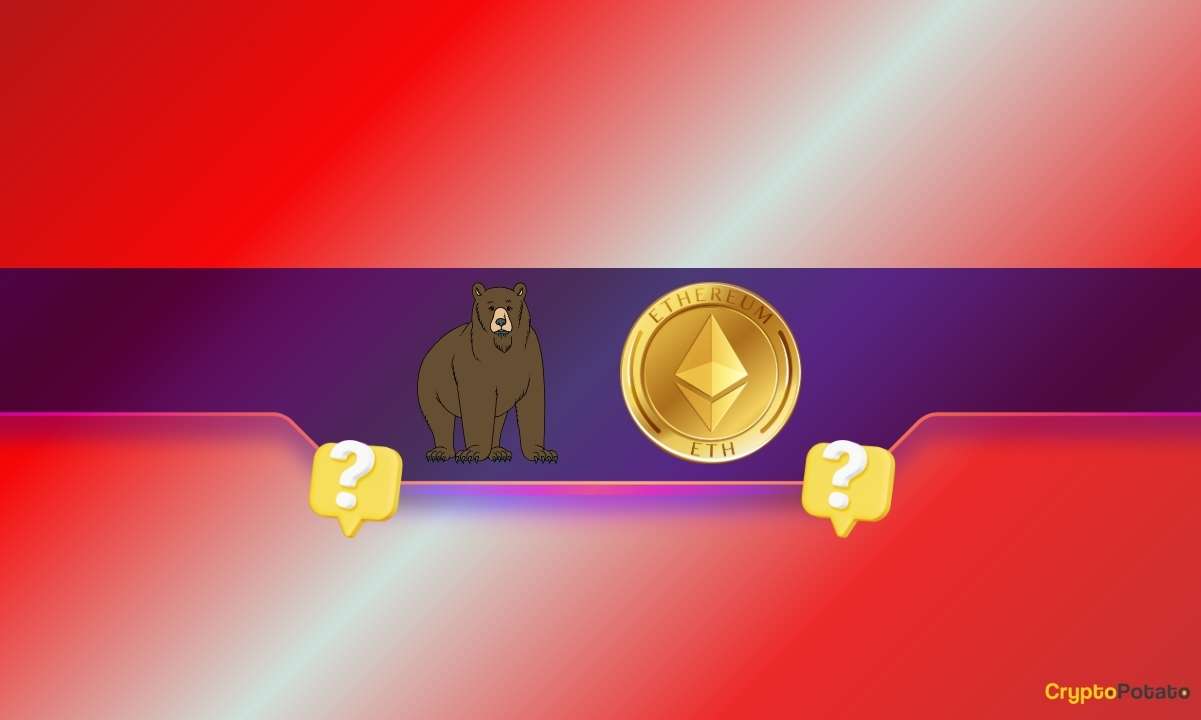
TL;DR
- Whales, hackers, and the Ethereum Foundation wallets moved over $500M in ETH through large sales and withdrawals.
- Ethereum transfers rose to 4.6M ETH, nearing the monthly high of 5.2M recorded in July.
- Staking inflows hit 247,900 ETH, the highest in a month, locking more supply from trading.
Large Withdrawals and Whale Activity
Ethereum (ETH) has seen heavy movement from major wallets over the past few days. On-chain data from Lookonchain shows a newly created wallet pulled 17,591 ETH, worth $81.62 million, from Kraken in just two hours.
Over three days, two new wallets withdrew a combined 71,025 ETH, valued at $330 million, from the exchange.
One of these wallets, address 0x2A92, has withdrawn 53,434 ETH, worth $242.34 million, in two days. This includes a recent purchase of 30,069 ETH, valued at $138.46 million, during a market drop.
Major ETH Holders Offload Millions Amid Price Rally
In contrast, several separate entities have been disposing of some ETH holdings. A wallet tied to a hacker address 0x17E0 sold 4,958 ETH for $22.13 million at $4,463, securing a profit of $9.75 million. Earlier this year, the same address sold 12,282 ETH at $1,932 and later bought back part of the amount at higher prices.
A different whale sold 20,600 ETH for $96.55 million over the past two days, generating a profit of more than $26 million after holding the position for nine months.
Meanwhile, an Ethereum Foundation-linked wallet, 0xF39d, sold 6,194 ETH worth $28.36 million in the last three days at an average price of $4,578.
Recent sales from the same wallet included an additional 1,100 ETH and 1,695 ETH for over $12.7 million combined.
The #EthereumFoundation-linked wallet(0xF39d) sold another 1,300 $ETH($5.87M) at $4,518 ~11 hours ago.
Over the past 3 days, this wallet has sold a total of 6,194 $ETH($28.36M) at an average price of $4,578.https://t.co/4hfCWymHVG pic.twitter.com/ErUyEY8SJy
— Lookonchain (@lookonchain) August 15, 2025
Network Activity on the Rise
CryptoQuant data shows Ethereum’s total tokens transferred have been climbing since August 9. After ranging between 1 million and 3 million ETH through late July and early August, transfers have risen to 4.6 million ETH, approaching the monthly high of 5.2 million recorded in mid-July. This increase has occurred alongside a price rally from about $3,400 to $4,600.
Interestingly, staking inflows generally stayed between 20,000 and 80,000 ETH per day over the past month. On August 14, inflows jumped to 247,900 ETH, the highest in the period.
At the time, ETH was trading near $4,600. Large staking deposits reduce the amount of ETH available for immediate trading, as staked coins are locked for a set period.
In the meantime, ETH trades at $4,647 with a 24-hour volume of $68.25 billion, down 2% on the day but up 19% over the week.
Binance Free $600 (CryptoPotato Exclusive): Use this link to register a new account and receive $600 exclusive welcome offer on Binance (full details).
LIMITED OFFER for CryptoPotato readers at Bybit: Use this link to register and open a $500 FREE position on any coin!
Cryptocurrency
Massive DOGE Whale Activity Hints at $1 Breakout
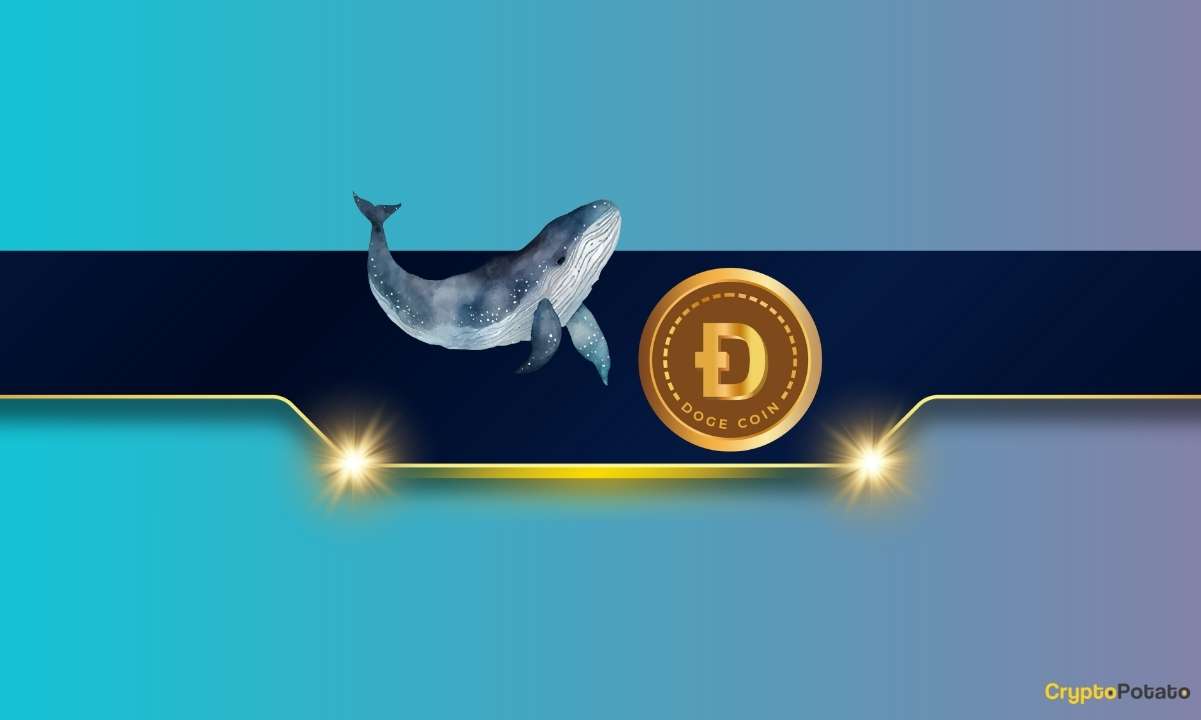
TL;DR
- Whales bought two billion DOGE this week, lifting their combined holdings to 27.6 billion coins.
- A single 900M DOGE transfer worth $208M to Binance drew attention to large exchange movements.
- DOGE broke key resistance, with momentum building for a possible push toward the $1 price mark.
Price and Market Moves
Dogecoin (DOGE) traded at $0.23 at press time, slipping 4% over the past day but still showing a 2% gain for the week. Daily turnover came in at about $6.18 billion.
Meanwhile, the broader crypto market saw over $1 billion in liquidations. Hotter-than-expected US Producer Price Index data pushed traders to scale back expectations of a near-term Federal Reserve rate cut. DOGE had roughly 290,500 coins liquidated during the sell-off.
On the two-week chart, analyst Trader Tardigrade notes that DOGE has cleared a downward-sloping resistance line after completing what appears to be a “wave V” in an Elliott Wave sequence. Similar setups in the past, where prolonged declines stayed within falling channels before breaking higher, have been followed by sharp rallies.
$Doge/2-week#Dogecoin is gaining strong momentum to surge above $1 pic.twitter.com/TuSEKr19nv
— Trader Tardigrade (@TATrader_Alan) August 15, 2025
Momentum gauges are also turning up. The Stochastic RSI, which had dropped into oversold territory, is now heading higher. Previous reversals from this zone have coincided with sustained upward moves. The current formation points to a possible run that could carry DOGE past the $1 mark.
Heavy Whale Buying and Large Transfers
As reported by CryptoPotato, blockchain data shows large investors have added two billion DOGE in the past week, spending just under $500 million. That brings their holdings to about 27.6 billion coins, or 18% of the supply. The buying streak has prompted speculation within the community.
Recently, Whale Alert flagged a 900 million DOGE transfer worth about $208 million into Binance. The tracking indicates that it originated from a wallet connected to the exchange, likely as an internal activity. The address involved holds 2.88 billion DOGE, one of the largest balances on the network.
Ali Martinez also reports that transactions above $1 million reached a one-month high, with activity building since early August and peaking as DOGE traded at $0.25.
Whales are back! Dogecoin $DOGE activity at a 1-month high. pic.twitter.com/C83Pv68mCt
— Ali (@ali_charts) August 14, 2025
Sentiment Building
Analyst Gordon described the current setup as “a nice bit of consolidation” before a potential breakout, adding,
“This will be one of the first coins normies FLOCK to & the pump will be MASSIVE.”
With whale accumulation rising, high-value transfers increasing, and a bullish technical pattern in play, DOGE is positioned for a potential push toward $1 if momentum holds.
Binance Free $600 (CryptoPotato Exclusive): Use this link to register a new account and receive $600 exclusive welcome offer on Binance (full details).
LIMITED OFFER for CryptoPotato readers at Bybit: Use this link to register and open a $500 FREE position on any coin!
Cryptocurrency
Ripple Price Analysis: XRP at Risk as Key Support Levels Could Trigger Sharp Drop
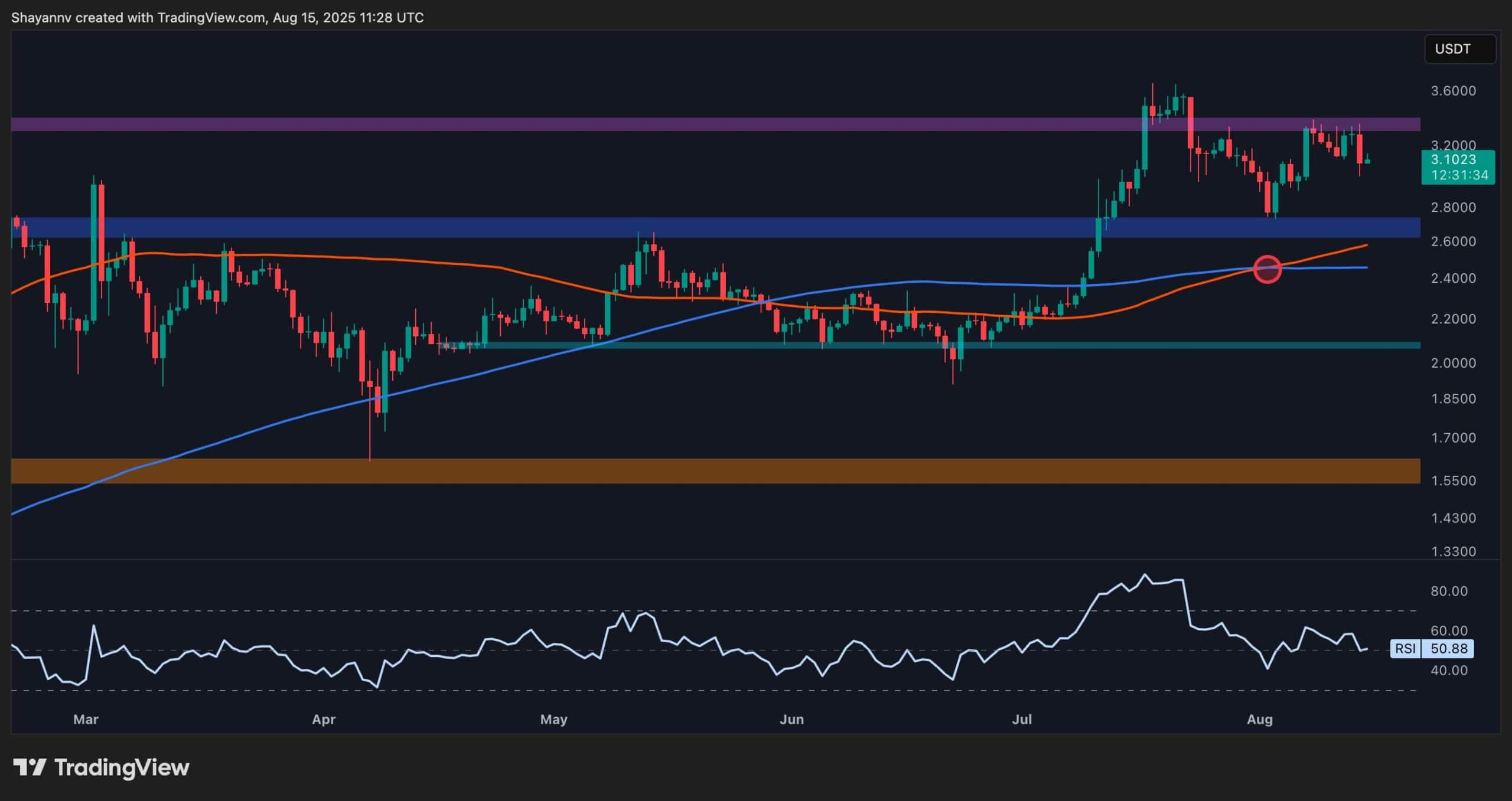
XRP has recently entered a consolidation phase after a strong rally earlier this summer, with the price action now hovering around key resistance levels on both its USDT and BTC pairs. Yet, while momentum has slowed, the charts still indicate a generally bullish structure, with multiple key support levels remaining firmly in place.
Technical Analysis
By ShayanMarkets
The USDT Pair
On the XRP/USDT daily chart, the price is currently trading near the $3.10 mark, facing a strong resistance zone around $3.40. This follows a breakout above the $2.70 range in July, which has now flipped into a support area.
Both the 100-day and 200-day moving averages are also trending upward and recently formed a bullish crossover around $2.45, reinforcing the medium-term bullish sentiment. If the $3.40 resistance breaks, a push toward the critical $4.00 range becomes likely.
However, the RSI hovering near the neutral 50 level suggests a lack of strong momentum for now, meaning a short-term pullback into the $2.80 support zone is still possible.
This zone will be key for maintaining the bullish structure. Losing it could open the door for a deeper correction toward the 200-day moving average located around the $2.40 mark. Yet, as long as the price stays above the moving averages, the broader trend remains bullish.
The BTC Pair
Looking at the XRP/BTC chart, the pair has recently pulled back after hitting the 3,000 SAT resistance, with the price currently around 2,600 SAT.
This follows a clean breakout above the long-term descending channel and a successful retest of its upper boundary, which coincided with the 200-day moving average and the 2,400 SAT support zone. This confluence remains a key bullish technical factor, as holding above it could attract renewed buying pressure.
That said, RSI levels around 48 show that momentum has cooled after the sharp July rally, meaning XRP may continue ranging between 2,400 SAT and 3,000 SAT in the near term. A decisive close above 3,000 SAT would likely open the path to the 3,400 SAT zone, while losing 2,400 SAT could shift the bias back toward 2,000 SAT support. For now, the structure still favors the bulls as long as higher lows remain intact.
Binance Free $600 (CryptoPotato Exclusive): Use this link to register a new account and receive $600 exclusive welcome offer on Binance (full details).
LIMITED OFFER for CryptoPotato readers at Bybit: Use this link to register and open a $500 FREE position on any coin!
Disclaimer: Information found on CryptoPotato is those of writers quoted. It does not represent the opinions of CryptoPotato on whether to buy, sell, or hold any investments. You are advised to conduct your own research before making any investment decisions. Use provided information at your own risk. See Disclaimer for more information.
Cryptocurrency charts by TradingView.

 Forex3 years ago
Forex3 years agoForex Today: the dollar is gaining strength amid gloomy sentiment at the start of the Fed’s week

 Forex3 years ago
Forex3 years agoUnbiased review of Pocket Option broker

 Forex3 years ago
Forex3 years agoDollar to pound sterling exchange rate today: Pound plummeted to its lowest since 1985

 Forex3 years ago
Forex3 years agoHow is the Australian dollar doing today?

 Cryptocurrency3 years ago
Cryptocurrency3 years agoWhat happened in the crypto market – current events today

 World3 years ago
World3 years agoWhy are modern video games an art form?

 Commodities3 years ago
Commodities3 years agoCopper continues to fall in price on expectations of lower demand in China

 Economy3 years ago
Economy3 years agoCrude oil tankers double in price due to EU anti-Russian sanctions



